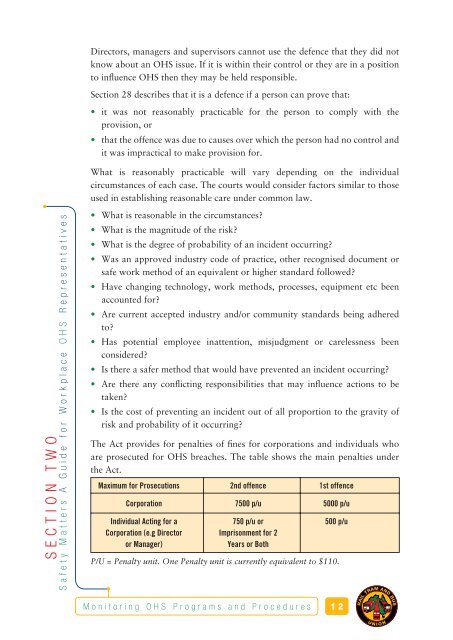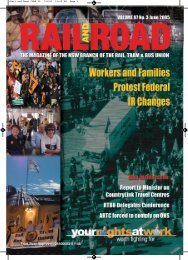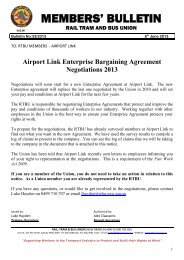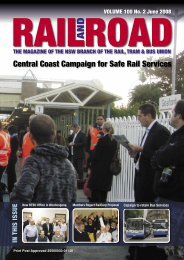Safety Matters - Rail, Tram and Bus Union of NSW
Safety Matters - Rail, Tram and Bus Union of NSW
Safety Matters - Rail, Tram and Bus Union of NSW
You also want an ePaper? Increase the reach of your titles
YUMPU automatically turns print PDFs into web optimized ePapers that Google loves.
Directors, managers <strong>and</strong> supervisors cannot use the defence that they did not<br />
know about an OHS issue. If it is within their control or they are in a position<br />
to influence OHS then they may be held responsible.<br />
Section 28 describes that it is a defence if a person can prove that:<br />
• it was not reasonably practicable for the person to comply with the<br />
provision, or<br />
• that the <strong>of</strong>fence was due to causes over which the person had no control <strong>and</strong><br />
it was impractical to make provision for.<br />
What is reasonably practicable will vary depending on the individual<br />
circumstances <strong>of</strong> each case. The courts would consider factors similar to those<br />
used in establishing reasonable care under common law.<br />
SECTION TWO<br />
<strong>Safety</strong> <strong>Matters</strong> A Guide for Workplace OHS Representatives<br />
• What is reasonable in the circumstances?<br />
• What is the magnitude <strong>of</strong> the risk?<br />
• What is the degree <strong>of</strong> probability <strong>of</strong> an incident occurring?<br />
• Was an approved industry code <strong>of</strong> practice, other recognised document or<br />
safe work method <strong>of</strong> an equivalent or higher st<strong>and</strong>ard followed?<br />
• Have changing technology, work methods, processes, equipment etc been<br />
accounted for?<br />
• Are current accepted industry <strong>and</strong>/or community st<strong>and</strong>ards being adhered<br />
to?<br />
• Has potential employee inattention, misjudgment or carelessness been<br />
considered?<br />
• Is there a safer method that would have prevented an incident occurring?<br />
• Are there any conflicting responsibilities that may influence actions to be<br />
taken?<br />
• Is the cost <strong>of</strong> preventing an incident out <strong>of</strong> all proportion to the gravity <strong>of</strong><br />
risk <strong>and</strong> probability <strong>of</strong> it occurring?<br />
The Act provides for penalties <strong>of</strong> fines for corporations <strong>and</strong> individuals who<br />
are prosecuted for OHS breaches. The table shows the main penalties under<br />
the Act.<br />
Maximum for Prosecutions 2nd <strong>of</strong>fence 1st <strong>of</strong>fence<br />
Corporation 7500 p/u 5000 p/u<br />
Individual Acting for a 750 p/u or 500 p/u<br />
Corporation (e.g Director Imprisonment for 2<br />
or Manager)<br />
Years or Both<br />
P/U = Penalty unit. One Penalty unit is currently equivalent to $110.<br />
Monitoring OHS Programs <strong>and</strong> Procedures<br />
12<br />
RAIL<br />
TRAM AND BUS<br />
U N<br />
I O N

















